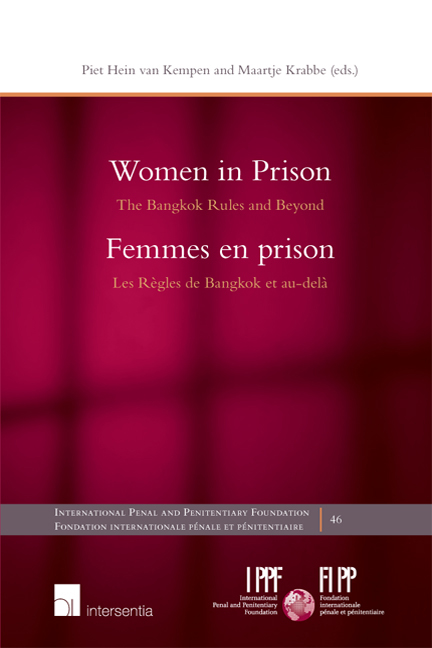Book contents
- Frontmatter
- Foreword
- Avant-propos
- Acknowledgements
- Remerciements
- Contents
- Part I Introductory Synthesis and Analyses: 1ÈRE Partie Synthèse ET Analyses Introductives
- Part II Themes: 2ÈME Partie Thèmes
- Women, crime and incarceration: exploring pathways of women in conflict with the law – The case of South Africa
- Variations and growth in the levels of female imprisonment
- Protection of women in prison under the European Convention on Human Rights
- European standards relating to non-judicial protection of women in prison
- Protection of women in prison in Asia: positive developments, weaknesses, opportunities and threats – perspectives from UNAFEI and its participating countries
- Implementation of the Bangkok Rules in Thai prisons
- The design of women's prisons: an architectural perspective on gender-specific needs and realities of female prisoners and main requirements for improvement
- Part III National Reports: 3ÈME Partie Rapports Nationaux
- Appendix The Bangkok Rules: Annexe Règles De Bangkok
- The International Penal and Penitentiary Foundation: History and Purpose
Implementation of the Bangkok Rules in Thai prisons
from Part II - Themes: 2ÈME Partie Thèmes
Published online by Cambridge University Press: 25 September 2018
- Frontmatter
- Foreword
- Avant-propos
- Acknowledgements
- Remerciements
- Contents
- Part I Introductory Synthesis and Analyses: 1ÈRE Partie Synthèse ET Analyses Introductives
- Part II Themes: 2ÈME Partie Thèmes
- Women, crime and incarceration: exploring pathways of women in conflict with the law – The case of South Africa
- Variations and growth in the levels of female imprisonment
- Protection of women in prison under the European Convention on Human Rights
- European standards relating to non-judicial protection of women in prison
- Protection of women in prison in Asia: positive developments, weaknesses, opportunities and threats – perspectives from UNAFEI and its participating countries
- Implementation of the Bangkok Rules in Thai prisons
- The design of women's prisons: an architectural perspective on gender-specific needs and realities of female prisoners and main requirements for improvement
- Part III National Reports: 3ÈME Partie Rapports Nationaux
- Appendix The Bangkok Rules: Annexe Règles De Bangkok
- The International Penal and Penitentiary Foundation: History and Purpose
Summary
INTRODUCTION
It was the first time that Thailand could perform the key role in bringing about international recognition of United Nations standards and norms, i.e. “the United Nations Rules for the Treatment of Women Prisoners and Noncustodial Measures for Women Offenders”, usually known as “the Bangkok Rules”. Although it is not officially mandatory for countries to implement the Rules, it is expected that ultimately States should conform with the Rules in order to improve prison standards, particularly as to the custody and treatment of their female prisoners. Thailand is obviously one of the nations placing considerable emphasis on these Rules, and it has actively started to work on the implementation process.
The effective implementation of the Bangkok Rules in Thailand seems particularly complicated, since it is influenced by many factors. This chapter provides a brief analysis of the characteristics of female prisoners in Thailand and discusses what Thailand has done towards implementing the Bangkok Rules in its correctional facilities.
THAI WOMEN PRISONERS: SOME GENERAL CHARACTERISTICS
It is worth mentioning that most women prisoners in the Thai prisons seem to be both offenders and victims. In fact, they are victims of the society. This is because research and studies on the characteristics of women prisoners in Thailand have established that the majority of Thai women prisoners committed drug offenses. According to the statistics (see Figure 1), about 82% of the total female prison population committed crimes contrary to the narcotics laws, while only 13% of them were convicted for crimes against property. Among these female property offenders, approximately 32% were likely to be motivated by an underlying drug problem: they committed property crimes in order to earn money to buy drugs. In addition, it was found that nearly 70% of the female drug prisoners, in particular the small-scale drug dealers, developed from being drug users into dealers. These female drug prisoners usually came from the lower socio-economic classes, had family problems, indulged in vices and had limited social opportunities as well.
Furthermore, studies have shown that some of the female prisoners had been persuaded to commit crimes by their lovers or friends. Some were lured into the business under false pretences. Other women entered the drug business because they believed it was an easy and quick source of income, especially when they were unemployed.
- Type
- Chapter
- Information
- Women in PrisonThe Bangkok Rules and Beyond, pp. 153 - 160Publisher: IntersentiaPrint publication year: 2017



